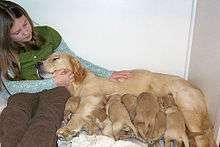Goldendoodle
 A Goldendoodle | |||||||||||||||||||||||||||||||||||||||||
| Origin | Canada/U.S.A | ||||||||||||||||||||||||||||||||||||||||
|---|---|---|---|---|---|---|---|---|---|---|---|---|---|---|---|---|---|---|---|---|---|---|---|---|---|---|---|---|---|---|---|---|---|---|---|---|---|---|---|---|---|
| Breed status | Not recognized as a standardized breed by any major kennel club. | ||||||||||||||||||||||||||||||||||||||||
| |||||||||||||||||||||||||||||||||||||||||
| Domestic dog (Canis lupus familiaris) | |||||||||||||||||||||||||||||||||||||||||
A Goldendoodle is a cross-breed obtained by breeding a golden retriever with a poodle. The name (which alters "poodle" to "doodle" in reference to the Labradoodle) was coined in 1992.
History
In the 1990s,[1] breeders in both North America and Australia began crossing golden retrievers with standard poodles.[2] The original purpose of the cross was to attempt to develop guide dogs suitable for visually impaired individuals with allergies. The goldendoodle is sometimes called a designer dog. The Encyclopedia Britannica traces the term "designer dog" to the late 20th century, when breeders began to cross purebred poodles with other purebred breeds in order to obtain a dog with the poodle's non-shedding coat, along with various desirable characteristics from other breeds.[3]
Shedding Amount
Although not all goldendoodles exhibit the non-shedding coat type of the standard poodle, most goldendoodles do have a low to non-shedding coat.[2] The goldendoodle is usually tolerable for people with allergies, especially a goldendoodle with a completely non-shedding coat. The goldendoodle may shed less than a golden retriever, but the degree of shedding will vary from dog to dog. Grooming requirements are as varied as coat types, but most doodles require regular brushing to avoid matting. A dog with a coat that sheds less will require more grooming than one that sheds more often. Most people are not allergic to the fur, but the skin of a dog; Goldendoodles tend to have less dander though. [4] While some breeders claim that the goldendoodle is a hypoallergenic dog, no studies have proven that any canine is completely hypoallergenic.[5]
Appearance

There are three main coat types. There is the straight coat, which is flat and resembles more of a golden retriever coat. The wavy coat type is a mixture of a poodle's curls, and a golden retriever's straighter coat. The last coat type is curly, which tends to look more like the poodle coat. A goldendoodle's size is generally somewhere between that of its poodle parent and golden retriever parent. The ranges of size include standard, medium, and miniature (if the poodle parent was miniature). Upon reaching adulthood, a standard goldendoodle will often weigh 60 to 100 pounds. A medium goldendoodle will weigh between 30 and 45 pounds and a miniature goldendoodle will weigh approximately 15 to 30 pounds. The standard in height at the shoulder for a male goldendoodle is about 24-26 inches. For females, it is 22-23 inches. Often, taller goldendoodles inherit more from the golden retriever and will weigh substantially more. It is very common for the goldendoodle to inherit the "golden retriever bump" on top of his/her head.[2][6] Common coat colors include white, cream, apricot, gold, red, and sometimes gray and black (also called phantom). Goldendoodles may also be black or a light sandy brown.[7] They are classified into types according to the breed of its parents. An F1 goldendoodle is the offspring of a poodle mated with a golden retriever. An F1B goldendoodle is the offspring of a poodle with an F1 goldendoodle.[8] An F2 goldendoodle is the offspring of an F1 and another F1 goldendoodle, and an F2B goldendoodle is the offspring of an F1 and an F1B goldendoodles.
Breed status

Some breeders prefer to restrict breeding to the first generation (F1) and first generation cross-back (F1B).[4] This is done in an attempt to maximize genetic diversity and avoid the inherited health problems that have plagued many dog breeds.[8]
Established breed associations such as the AKC, the UKC, and the CKC, do not recognize this hybrid, or any other designer cross, as a breed. However, some major kennel clubs do accept registration of crossbreed and mixed-breed dogs for performance events such as agility and obedience such as the Continental Kennel Club. The Continental Kennel Club will accept and grant a pedigree on a goldendoodle as long as the parents have registration.
Health
With knowledgeable breeding, the goldendoodle tends to be a rather healthy dog, but poodles and golden retrievers are both susceptible to hip dysplasia. Therefore, an OFA or PennHIP exam is required to check for this problem before dogs are bred.
Both breeds can also suffer from a number of inheritable eye disorders, so it is important that annual CERF (Canine Eye Registration Foundation) exams are performed before breeding. The goldendoodle inherits the ears of golden retrievers; because their ears hang and don't allow the water to drain, they are prone to ear infections (and yeast infections in the ears) from swimming. Von Willebrands disease (vWD), a bleeding disorder can also be found in the poodle and should be screened through DNA tests before breeding.
Usage
Since 2005, Goldendoodles have been moderately used as guide dogs, therapy dogs, diabetic dogs, search dogs and rescue dogs, as they have inherited the poodle's intelligence and the golden retriever's ease of training.[9] Goldendoodles have also become increasingly used as domestic pets due to their affection towards families, friendliness and patience with kids and strangers.[10]
See also
References
| Wikimedia Commons has media related to Goldendoodle. |
Citations
- ↑ Wheeler 2008, p. 11
- 1 2 3 "FAQ: Goldendoodles". The Goldendoodle and Labradoodle website. Retrieved 2010-08-29.
- ↑ Encyclopædia Britannica (online), designer dog
- 1 2 "Doods & Generations". The Goldendoodle and Labradoodle Website. Retrieved 2010-08-29.
- ↑ "Hypoallergenic Dogs Not Allergy-Proof, Study Finds | Hypoallergenic Dogs, Pet Dander & Pet Hair Allergies". LiveScience. 2011-07-11. Retrieved 2013-05-06.
- ↑ MacKenzie, Edie (2009). Goldendoodles: Complete Pet Owner's Manual. Barron's Educational Series, Inc. ISBN 0-7641-4290-9.
- ↑ "Dood Coat Colours". The Goldendoodle & Labradoodle Website. Retrieved 2011-09-07.
- 1 2 John Armstrong (2001). "The Poodle and the Chocolate Cake". The Canine Diversity Project. Archived from the original on 5 January 2011. Retrieved 2010-08-29.
- ↑ "Service dogs". Goldendoodle Association of North America. Retrieved 25 November 2014.
- ↑ "Goldendoodle Dog Breed Information, Pictures, Characteristics & Facts – Dogtime". Dogtime. Retrieved 2016-11-23.
Bibliography
- Hoc, Ilene (2007), Dogs by Design: How to Find the Right Mixed Breed for You, Sterling Publishing, ISBN 978-1-4027-4354-2
- Wheeler, Jill (2008), Goldendoodles, Checkerboard Books, ISBN 978-1-59928-963-2